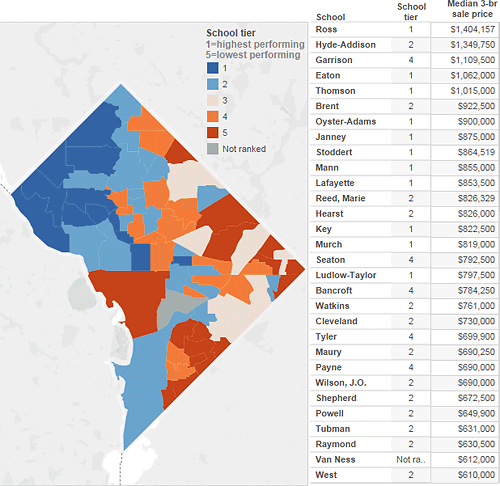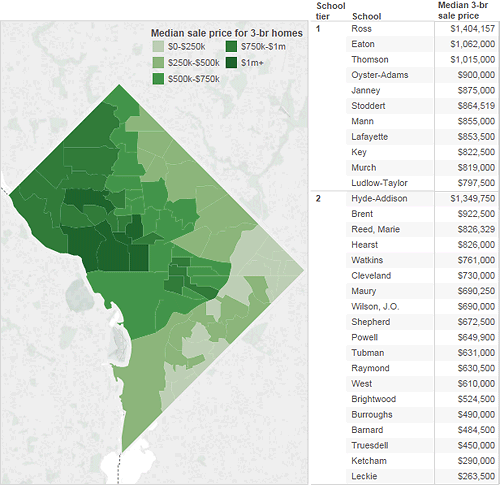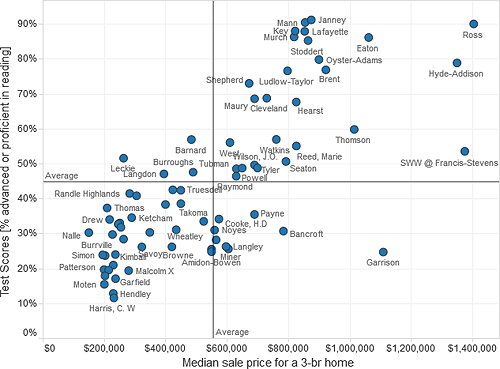It’s more expensive to live in a good school district, with a few exceptions
Generally speaking, higher test scores at a DC Public School elementary school correlate with higher housing costs. But there are a few “bargain” neighborhoods, and one outlier school that’s surrounded by pricey housing despite low scores.
The median price of a typical three-bedroom home within the attendance zone of a top-scoring DCPS elementary school is over $800,000, according to District Measured, a blog produced by DC’s Office of Revenue Analysis. At those schools, largely in Northwest DC, 80% or more students score proficient or advanced in reading.
At the next tier down, schools where 60 to 80% of students are proficient or advanced, housing prices aren’t much lower: median sale prices vary from the high $600,000s to over $1 million.
If you want to pay less than that, you may have to go to a neighborhood where the zoned school has reading proficiency rates below 60%.
In addition to a graph that correlates reading test scores and median sale prices, the ORA has created two maps. The first one shows school zones according to school rankings, and you can filter it by median home prices.
 Click here for interactive version.
Click here for interactive version.
The second map shows home sale prices. You can filter it by school rankings.

Click here for interactive version.
ORA used the school boundaries that will go into effect this coming fall. Those new boundaries only apply to students entering the DCPS system. Students who are currently enrolled at a school can stay there even if the boundaries change.
In creating the interactive maps, ORA divided schools into five tiers based on the federal government’s system of tracking school performance. The federal categories are primarily based on students’ scores on DC’s standardized tests, factoring in the number of students who score proficient or advanced and the growth of students from one year to the next.
The maps show that there’s a range of housing prices attached to schools within a given category, outside of the highest tier. Both Nalle and School Without Walls at Francis-Stevens are in tier two, for example. But the median home price in Nalle’s zone in Ward 7 is $150,500, while in Francis-Stevens’ zone, in Ward 2, it’s $1,375,000.
Garrison Elementary, in Logan Circle, is the biggest outlier on the graph and maps. The school is in the next-to-last tier, four, with a reading proficiency rate in the mid-20s. But the median home price in its zone is over a million dollars. That’s above the median price in the zone for John Eaton, a tier one school located in well-to-do Cleveland Park.
Of course, median home prices don’t just reflect the desirability of a neighborhood school. Some residents either no longer have school-age kids or don’t plan to. And in DC, even those who are concerned about school quality know they’re not necessarily limited to the school they’re zoned for.
Almost half the public school students in DC attend charter schools, and admission to them is determined by lottery rather than location. Even within the DCPS system, many students attend a school other than the one they’re zoned for—40% did so in 2012, according to ORA. Overall, only about 25% of DC students attend their assigned school.
Still, there’s value to having a guaranteed seat at a high-performing elementary school. That’s reflected in home prices in DC as in Montgomery County and elsewhere. If you filter ORA’s school performance map for increasingly lower-priced housing, you can see the available area shrink and the high-performing zones decrease.
By the time you get to a median price of under $500,000, the map is a ribbon along the eastern edge of the District, where most of the schools fall into the lowest three tiers.
 Cross-posted at DC Eduphile.
Cross-posted at DC Eduphile.

